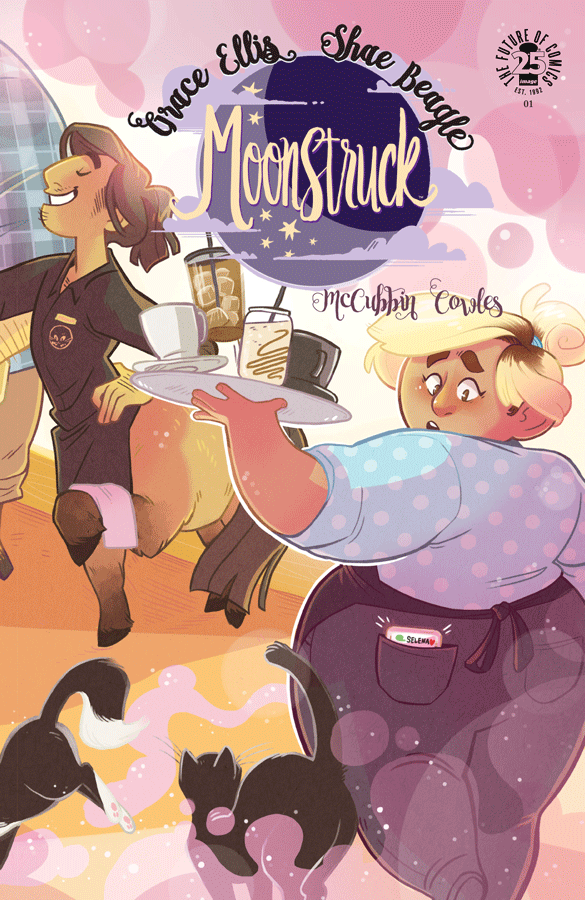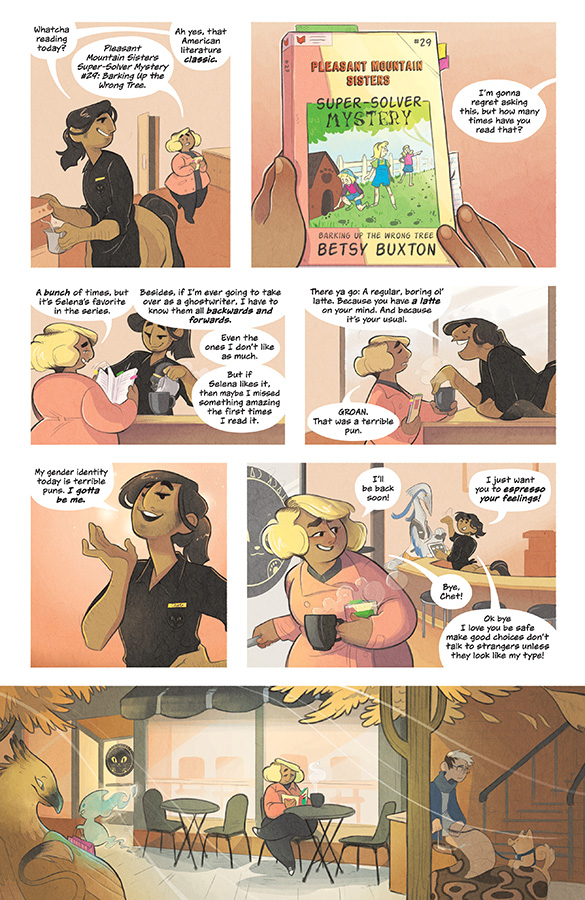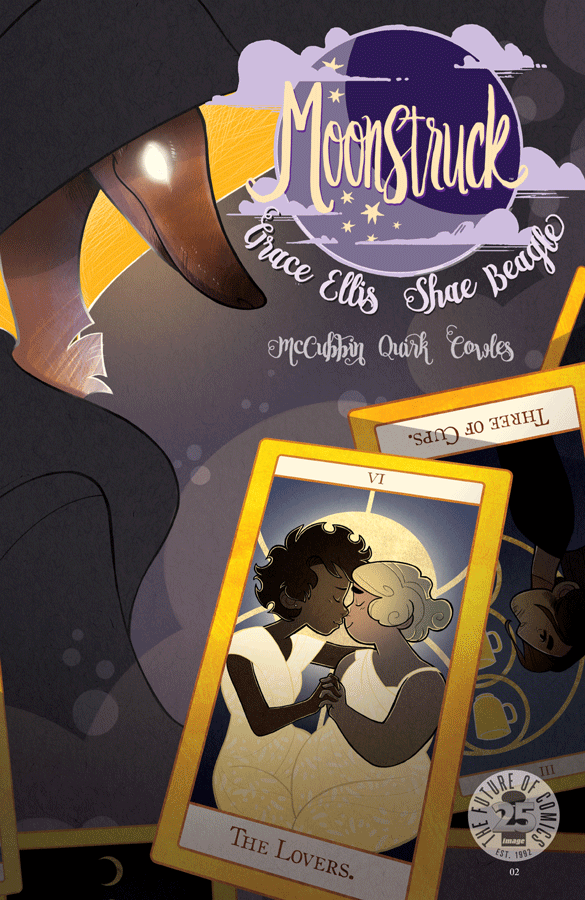Welcome to the latest installment of my comics review column here at Skiffy & Fanty! Every month, I use this space to shine a spotlight on SF&F comics (print comics, graphic novels, and webcomics) that I believe deserve more attention from SF&F readers.
This month, I’d like to focus on the first two issues of a new ongoing comics series, Moonstruck #1 and 2. (This review contains spoilers!)

Written by Grace Ellis
Art by Shae Beagle; additional art by Kate Leth
Colors by Caitlin Quirk
Lettering by Clayton Cowles
Edited and Designed by Laurenn McCubbin
Published by Image Comics
Moonstruck is, in a word, delightful. Two issues of this new, all-ages series have been published to date (the third is due out on October 3, 2017, so you can get caught up at your friendly local comic shop then).
Julie, a shy werewolf, is at the very beginning of a romantic relationship with a new girlfriend, Selena, who is probably also a werewolf. Julie works at a coffee shop with Chet, a centaur who hits the sassy best friend trope pretty hard, but they’re also a centaur who uses they/their as their pronouns and are funny as heck, so there’s enough going on there that they aren’t just a type.

There’s Julie’s sort-of friends, a gorgon and a dryad of some sort who are in a band and a dude who might be a vampire or maybe some kind of were-bat who just dramatically quit the band again. There’s an oracle and a prophecy. There’s a mysterious magic show with cliffhanging consequences. There’s a story within the story about a middle-grade book series that Julie and Selena share a love for.
The diversity of the cast goes unremarked-upon in the story, but it’s an important part of the charm. Wide ranges of body types, the centering of a lesbian couple, different skin tones: this is a story, and a place, that feels inhabited by a true breadth and range of people, very much like the place I live in.
Except, you know, for the werewolves and centaurs and whatnot. We don’t have those in Toronto. That I know of.
Comics and urban fantasy seem like they should be a natural fit. Historically, though, in the North American print comics industry, urban fantasy has been a present but not pronounced subgenre. Some superhero comics have approached urban fantasy in tone, and there have been a number of excellent and significant small-press or self-published works in the genre. The most obvious and well-known genre antecedents are comics like Matt Wagner’s Mage, and of course Sandman, or parts of Sandman, anyway, and the comics published around and after it via DC’s Vertigo imprint. But as influential and important as Mage was, as Sandman was, I don’t see the footprints of Morpheus or Kevin Matchstick in Moonstruck.
More clear are the impacts that flow from the popularization and incredible success of manga in North America, and the rise of webcomics. Not so much as direct creative influences, but both of those elements set the stage for a greater diversity of art styles, subject matter, pacing, and genre and subgenre – as well as cheerful genre-blending.
A work like this might have been conceived and launched in, say, the ’80s black-and-white boom, or the ’90s self-publishing wave, but it would have occupied a niche within a niche, a poor fit in the Direct Market of comic shops built up mostly around superheroes. It would have been a probably insurmountable challenge for it to try to connect with a large enough audience to succeed in the long term.
That Moonstruck can exist – and, I hope, thrive – in the current North American comics market is a testament to the growth and breadth of the comics-reading audience.
Returning to inspirations and antecedents, though, I am very curious whether any of the creators are familiar with a work that I do see echoed in Moonstruck, though only broadly and thematically – Charm School, written and drawn by one of my favorite comics creators of the ’90s, Elizabeth Watasin. The style, tone, and specifics of the narrative were quite different, but Charm School too used the setting of a contemporary community of monsters and magical beings to tell a sweet love story that focused on a same-sex couple.
That being said, Moonstruck, speculation about influences aside, is very much its own story. Blending genres, as Moonstruck does, can be a challenge. Genres define expectations, and blending genres creates multiple, overlapping expectations that readers expect creators to fulfil.
I’ve been calling Moonstruck urban fantasy, so far, but it’s entirely possible it might be more akin to paranormal romance, or something in between the two. The noir tone common to so much current American urban fantasy is entirely absent. In its place are mostly light-hearted elements of both romantic comedy (it’s about a new relationship!) and situation comedy (the cast is a fractious friend group who work and hang out at a coffee shop!) But while many of the tropes associated with each of those genres are present, some quite overtly – I love Chet, but they really do wear the sassy friend role right on their sleeve – just as many tropes are averted, often quietly and subtly.
For instance, while plenty is happening, there’s been barely any violence; this is not an urban fantasy defined by anyone fighting monsters, at least so far – although Julie’s anxieties about getting angry and letting her werewolf traits manifest provides tension, and a hint that there is a risk of violence.
On the other hand, although I just referred to rom-coms, and while there’s plenty of humor, the story begins after girl and girl have, we can safely presume, already met-cute and had their first date. In media res is an unusual choice to start a romantic comedy, and one that I appreciated.
So far, Moonstruck is deftly managing to both fulfil and deny genre expectations, with the mild caveat that the narrative also hasn’t reached a point where the reader expectations of payoffs of its various constituent genres might be at odds with one another. I’m very eager to see how the creators address and resolve this as the story unfolds.

Shae Beagle’s art is lovely, a perfect match with the narrative and its tone. I want to call it soft, in the best way – it feels bright and positive and warm and like scenes from a movie shot in soft focus. The character designs are excellent — I mean, just look at Julie! Don’t you want to hug her? — and Beagle has a keen eye for comedic moments and details.
Caitlin Quirk’s colors contribute powerfully. I remember when publishing an independent comic in full color would have been impracticably costly, and while I still love black and white comics art, it’s wonderful that the economics of the industry have changed to the extent that creators can use the artistic options available via color and the talents of gifted colorists like Quirk in their comics to better express the story.
If I understand the credits correctly, the additional art by Kate Leth entails the Pleasant Mountain Sisters story – Julie and Selena’s mutually beloved children’s book series, which we see brief excerpts from, in comics form, in both issues of Moonstruck. Leth skillfully strikes a tricky balance, with art that effectively, with humor and affection, reflects the engaging but very earnest tone of a story written perhaps a bit too mindfully and simplistically for children.
At first I found the presence of this aspect puzzling. While I appreciated Julie and Selena having a shared interest, and related deeply to Julie geeking out over her favorite comfort-read books, I wondered if there might have been a more narratively economical way of achieving those goals than using several pages of comics to portray scenes from what’s meant to be a prose story.
You know what? I was wrong! It was only on my third reading of the comic, in immediate preparation to write this review, that I realized that the Pleasant Mountain Sisters, who are fictional, the story-within-the-story, are the only unquestionably “ordinary” humans we’ve seen so far in the story. This has fascinating implications, and raises fascinating questions. Is a non-magical world a diverting fantasy in this setting? Or are the books reflective of a wider world that Julie and her fellow magical creatures have been cast out of, or cut off from? Far from being an aside, the Pleasant Mountain Sisters books are subtle world-building, that serve to sneakily unlock an entire new layer of mystery about this story and its world, in ways that I suspect will eventually be addressed in the ongoing main plot.
Finally, on the subject of mysteries, I wonder about the title, and whether it’s a coincidence or a deliberate callback to the – also delightful – 1987 movie of the same name. I know, that was 30 years ago, but it’s top of mind because I only watched the film this year at the insistence of my Italian-Canadian girlfriend, who considers it vital to understanding her own family. If it’s homage, I’m deeply curious what that means, and how it will play out in the ongoing story of Julie and her relationship with Selena!
It’s sometimes a tricky thing, for me, discussing a series that’s still in its early days. There have been occasions in the past when I’ve loved early instalments of a comic to pieces only see it go in another direction.
But Moonstruck, right now, is sweet, funny, charming, surprising, interesting, and above all, it’s fun. It is, in a word, delightful.
That’s good enough for me to say, without reservation, that it deserves your attention and support.
Acknowledgements and Disclosures: I would like to acknowledge that Toronto, and the land it now occupies, where I live and work, has been a site of human activity for 15,000 years. This land is the traditional territory of the Huron-Wendat and Petun First Nations, the Seneca, and most recently, the Mississaugas of the Credit River. The territory was the subject of the Dish with One Spoon Wampum Belt Covenant, an agreement between the Iroquois Confederacy and Confederacy of the Ojibwe and allied nations to peaceably share and care for the resources around the Great Lakes. This territory is also covered by the Upper Canada Treaties. Today, the meeting place of Toronto is still the home to many Indigenous people from across Turtle Island. I am grateful to have the opportunity to live and work in the community of Toronto, on this territory.
I don’t have any personal or professional relationships I’m aware of with the creators or publisher. I purchased my own copies of the comics.









0 Responses